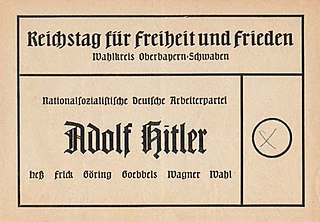Top Qs
Timeline
Chat
Perspective
1936 German parliamentary election and referendum
From Wikipedia, the free encyclopedia
Remove ads
Parliamentary elections were held in Germany on 29 March 1936.[1] They took the form of a single-question referendum, asking voters whether they approved of the military occupation of the Rhineland and a single party list for the new Reichstag composed exclusively of Nazis and 19 nominally independent "guests" of the party. Like previous votes in the Nazi era, it was rigged,[2] with a claimed turnout of 99% and 98.8% voting in favour. In a publicity stunt, a number of voters were packed aboard the airships Graf Zeppelin and Hindenburg, which flew above the Rhineland as those aboard cast their ballots.[3]
This was the first German election held after enactment of the 1935 Nuremberg Laws, which had removed citizenship rights (including the right to vote) from Jews and other ethnic minorities. In the previous elections and referendums under Nazi rule, Jews, Poles and other ethnic minorities had been allowed to vote without much interference, and even tacitly encouraged to vote against the Nazis (especially in districts that were known to have large populations of ethnic minorities). On 7 March 1936, Jews and Romani lost their right to vote.[4] Their removal from the electoral process accounted for much of the large drop in invalid and negative votes,[citation needed] which fell from over five million in 1934 to barely half a million in 1936. The Nazis also lowered the voting age, in large part so as to ensure that the electorate was about the same size as in 1934 but also to exploit the relatively enthusiastic support of younger Germans for the Nazi regime.
This also was the first election since the Saar was incorporated into Germany on 1 March 1935, following the Saar plebiscite of 13 January 1935. The new territory was merged with electoral constituency 27, Palatinate, which was now renamed Palatinate–Saar.[5]

Remove ads
Results
Aftermath
The new Reichstag convened for formulary procedures on 30 January 1937 to re-elect its Presidium and Hermann Göring as President of the Reichstag. It convened again to renew the Enabling Act of 1933 for additional four years.
The subsequent election in 1938 was held both in Germany and Austria, alongside a referendum that ratified the annexation of Austria to the German Reich.
See also
Notes
- Hitler, Rudolf Hess, Wilhelm Frick, Hermann Göring, Joseph Goebbels, Adolf Wagner, Karl Wahl.
References
External links
Wikiwand - on
Seamless Wikipedia browsing. On steroids.
Remove ads


